Juvenile Visceroid: First of the two phases in the Visceroid life cycle, this harmless form dwells in rich Tiberium fields. The Visceroids' origin and only means of reproduction are through an irregular mutation of a terrestrial animal. Visceroids vary in size and composition according to that of the mutated animal, but each share the same body structure: Visceroids are essentially a single, massive cell, conducting locomotion via pseudopod. Hence they can be referred to as giant amoeboids. Unlike the adult form, a juvenile Visceroid cannot use its pseudopod for attack nor defence.
Research shows that the juvenile Visceroids absorb Tiberium particles directly through the cell wall, acting as the creature's primary and only source of nutrition. The Visceroid's constant, wobbly motion serves to transport these nutrients inside the body and maintain homoeostasis. Like other Tiberium based life, it also possesses the fascinating ability of rapid cellular regeneration through Tiberium absorption and fixation into living tissue.
Adult Visceroid: Second of the two phases in the Visceroid life cycle, this form is dangerous to approach. Born of the fusion of two juvenile Visceroids, the adult form has twice the mass and twice the strength. It's aggressive by nature, and has the ability of using its pseudopod to attack and kill anything it deems a threat. The exact nature of its ability to perceive a threat remains a mystery, as these abominations are impossible to capture. They can simply slip through nets and cages with their irregular and constantly morphing body.
Research shows that the adult Visceroids absorb Tiberium particles directly through the cell wall, acting as the creature's primary source of nutrition. It has also been seen to cause terrestrial animals to mutate into juvenile Visceroids by attacking and enclosing them with its protoplasm. Like other Tiberium based life, the Visceroid also possesses the fascinating ability of rapid cellular regeneration through Tiberium absorption and fixation into living tissue.
Juvenile Floater: Nicknamed Jellyfishes due to their uncanny resemblance to the terrestrial invertebrate, these creatures levitate close to the ground like their namesake in shallow water. Not as dangerous as the adult form, juvenile Floaters nonetheless posses a great threat to anything organic and electric. Capable of generating a deadly electric field, they can shock-attack prey with their numerous tentacles. Fortunately, the juvenile Floaters are rather fragile, and only pose a real threat in numbers.
Floaters move like Jellyfishes, using jet propulsion to propel them in the air for short distances. This is thought to be the cause of the peculiar sounds these creatures are known for, resembling a singing whale. The exhaust gas seems to contain a high amount of Tiberium particles, therefore it is toxic to breathe. They seem to able to levitate while completely still, possibly due to the electromagnetic field they have the ability to generate. Whether Floaters are in fact mutated jellyfishes, and if they reproduce like their terrestrial counterparts, is unknown. The Floaters seem to thrive in Thorn-infested regions, so they may reproduce in these infested waters. Due to the infestation, research is extremely dangerous and rare.
Adult Floater: The mature Floater is a dangerous hunter. It can generate an electrical current of several amperes, enough to kill a man in an instant. These creatures employ electromagnetism in various ways, including the ability to levitate and to detect and track a potential prey while seemingly lacking other sensory organs. Their light and aerodynamic body allows them to briefly accelerate to speeds of over 60 mph, and there are cases where a group of Floaters raiding a civilian town have caught escaping civilian auto-mobiles.
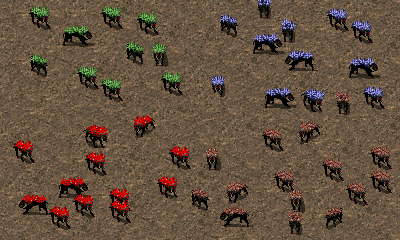
Tiberian Fiend (Riparia/Vinifera/Cruentia/Arborea): Vicious predators known for secreting themselves within Tiberium fields, it's hypothesised that these carnivores are derived from one of the following terrestrial taxonomic families: Canidae, Equida but most likely Suidae. Fiends are large quadrupeds with oily dark skin and a pair of large goring tusks but their most defining feature is a thick Tiberium growth that has erupted from their hide. This growth allows them to blend in with their surroundings, where they will patiently await their prey (usually Striders/Spring Worms). Once their quarry enters range the Tiberian Feind will proceed to attack by rapidly flinging these shards at the target.
Tiberian Fiends are fiercely territorial having been known to attack patrols, harvesting operations and even small outposts. However they posses a level of cunning and intellect that is amenable to a certain degree of domestication, but this is a task that only the Forsaken have managed to achieve.
Fiends come in four variations, each one correlating with the known strains of Tiberium. It is currently unclear as to how Fiends take on these characteristics, some speculate that they may have a symbiotic relationship with their host field, allowing it to take root on their hides supplanting their previous growth. Another hypothesis is that it is a natural part of their life cycle, that the Tiberium maturates depending on time and how well the predator has done. As such seeing these variations could be a sign of a successful elder.
Sabreworm: Swift and deadly, these large worm-like creatures are able to track even the slightest vibration in the soil. Sabreworms attack by bursting out of the ground while using their blade like appendages to slice their unsuspecting prey to shreds. They then drag the mutilated corpse back into the tunnel rupture to be consumed.
Caution, these creatures do not burrow deep enough for our sensor arrays to detect their movements. However, they have been known to burrow deeper while pursuing prey over long distances, only then do sensors detect them.
Wyvern: Named after the two-footed dragon of European mythology, these flying nightmares presumably evolved from the order Chiroptera. As with many species of Bat they hunt primarily during the night and sleep during the day, preferring to rest within secluded dark hideaways such as caves or crevasses. When attacking they will swoop down and either scoop their prey up into their mouth or lash out using their rending claws. It is commonly said no man has survived to tell the tale of a Wyvern attack.
Whaloon: Typically harmless, Whaloons are so named because of their huge size and delicate, buoyant bodies. They levitate by filling the specialized bladders in their abdomen with toxic but lighter-than-air gas. To propel themselves, they have a pair of fin-like structures on the sides of their bodies, which move in a wave-like pattern.
A Whaloon is only to be feared when threatened, as it will charge the trespasser and emit a plume of toxic gas. This behaviour is often seen when an individual Whaloon is driving away other Whaloons from its territory. Despite their size, Whaloons have a dangerously delicate body. If punctured, an unknown reaction with the air causes them to erupt violently, releasing the toxic gas within.
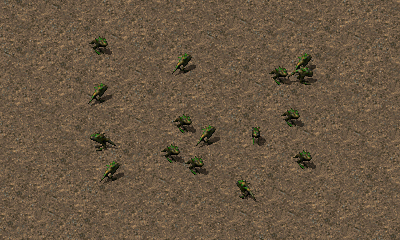
Strider: Commonly known as the Strider, this friendly two-legged creature is a harmless lifeform commonly seen in largely mutated and Tiberium infested regions. Whilst up close it definitely has a frightening appearance and is around the same size as an average human male, it is a class case of "it's more scared of you than you are of it", it will flee if approached and panic if attacked.
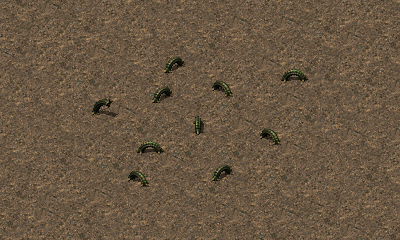
Spring Worm: Known by many names such as the Tiberian Slinky, Strider and the Tumbler. All of it's names were based on the creatures unusual movement, believed to be an advanced mutation of common earthworms (though this isn't known for sure), the Spring-Worm critter is a herbivore and will cause no intentional harm to any living creature.
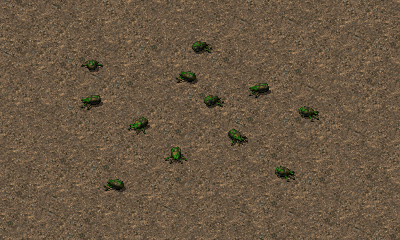
Tiberian Tick: These lifeforms are large insect-like creatures that move around in a similar jumping manner to the common flea. While these are in fact friendly lifeforms, they are known to explode violently if threatened as a form of (destructive) self-defence expelling harmful toxic gas at the same time. Approach at your own risk, ladies and gentlemen, for even harmless creatures can have a nasty side!
Mantis: Mantises, known commonly as "Bugs" because of their insectoid appearance, are a Tiberian species of unknown origin. These creatures are weak predators and pose little threat on their own, which is why they attack in groups. Mantises have even been reported roaming in swarms of thousands.
Despite the image of a large yet primitive insect, Mantises are extremely intelligent and social beings. They live in underground hives with indeterminable number of individuals. There are reports of Mantises gathering remains of human settlement and using them for their own needs, and even reports of a behaviour of what seems like "mourning" over a deceased fellow Mantis. Perhaps not all Tiberian life is not so alien after all...
Scarab: Another insectoid species, the Scarab is a gigantic, beetle-like creature with the witnessed ability to set cities ablaze with a monstrous, fiery breath. Their hard shell is nearly impervious to even the strongest anti-tank rounds. These hulking beasts are not to be reckoned with.
Tiberian Raptor: Extremely dangerous mutations with an unexplainable resemblance to the extinct dinosaurs. Whether they evolved from lizards or some other animal, their arms have nonetheless reverted into a pair of extremely sharp blades, which they use to kill their prey in an instant. Like Tiberium Fiends, their backs are covered with Tiberium shards, although there are no reports of these serving any purpose other than camouflage.
Elder Tiberian Raptor: A matured version of the Raptor, the Elders are bigger, stronger and even more dangerous than their juvenile counterparts. Apparently, once mature, the Raptors are either exiled from the Riparian community, or they leave on their own accord to conquer a territory from a Tiberium Vinifera field. Once successful, they live the rest of their life on these precious fields, sending their offspring to grow on the more abundant Riparian fields. Otherwise, the Elder Raptors might be a threat to the younger ones, a behaviour which is not uncommon in terrestrial fauna.
The Thing: A legendary, aquatic monster claimed to have been seen by very few people. Only rumours exist about the creature, but several tales about monsters in large bodies of water surrounded by Tiberium have spread around the world. How this or these species have become cosmopolitan in such a short time remains shrouded in mystery.










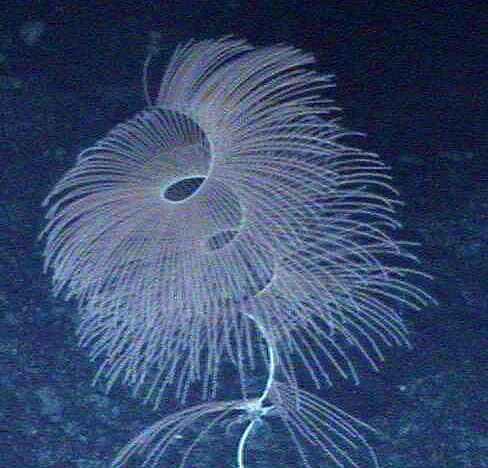
 [/img]
[/img]